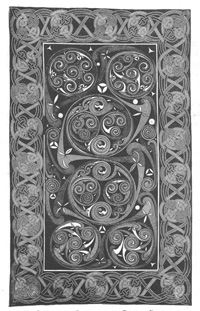Book of Durrow and the Book of Dimna - Irish Pictures (1888)
From Irish Pictures Drawn with Pen and Pencil (1888) by Richard Lovett
Chapter 1: Ireland’s Eye … continued
« Previous Page | Start of Chapter | Book Contents | Next Page »
While upon the subject of Irish illuminated MSS., and as they form such characteristic specimens of Irish art, we must refer to three others that enrich Trinity College Library. The first, the Book of Durrow, is a copy of the Gospels according to the Vulgate version. It 'gets its name from a monastery founded about 523 A.D. by Columba, at Durrow, or Dairmag; the Plain of Oaks, in King's County. Tradition has maintained that Columba wrote the MS., but the fact that the text of the MS. does not appear to be the same as that in use in Ireland in the sixth century tells against this view. On the back of folio 12 is an entry in Latin to this effect: 'I pray thy blessedness, O holy presbyter, Patrick, that whosoever shall take this book into his hands may remember the writer, Columba, who have myself written this Gospel in the space of twelve days by the grace of our Lord.'
Like several other of these ancient MSS., this copy of the Gospels once possessed a silver cumdach or shrine. This has unfortunately perished, but the inscription upon it has been preserved. It ran 'The prayer and benediction of St. Columb Kille be upon Flann, the son of Malachi, King of Ireland, who caused this cover to be made.'
Flann reigned 879-916 A.D., and at that early date the book had become an object of special veneration. In the Annals of Clonmacnois, the translator, Connell Mageoghegan refers to a superstitious belief once current with regard to this and other early books. 'He (Columba) wrote three hundred books with his own hand. They were all New Testaments; he left a book to each of his churches in the kingdom, which books have a strange property, which is, that if they or any of them had sunk to the bottom of the deepest waters, they would not lose one letter, or sign, or character of them; which I have seen tried, partly by myself on that book of them which is at Dorowe (Durrow) in the King's Co., for I saw the ignorant man that had the same in his custody, when sickness came on cattle, for their remedy, put water on the book and suffer it to rest therein; and saw also cattle return thereby to their former state; and the book receive no loss.'
The water-stained condition of some of the last leaves of the Book of Durrow confirms the accuracy of the scribe's statement as to the experiments to which ages ago it was subjected.
We are able to give a very fine specimen of one of the illuminated pages of this MS.
The second example, the Book of Dimna, so called after the name of the scribe who wrote it, a copy of the Gospels in Latin, dates most probably from the seventh century. It once belonged to the abbey of Roscrea. It was encased in a shrine about the middle of the tenth century. 'The shrine with its precious enclosure disappeared at the time of the dissolution of monasteries; it was found by boys hunting rabbits in the year 1789, among the rocks of the Devil's Bit Mountain in the county of Tipperary, carefully preserved and concealed. The boys who discovered it tore off the silver plate and picked out some of the lapis-lazuli with which it was studded. It then came into the possession of Dr. Harrison of Nenagh, and after passing through the hands of Mr. Monck Mason, Sir William Betham, and Dr. Todd, was finally purchased for the library.'[5]
NOTES
[5] Miss Stokes' Early Christian Art in Ireland, p. 24.
« Previous Page | Start of Chapter | Book Contents | Next Page »

